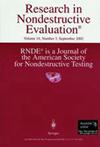增强声发射检测的导波研究
IF 1
4区 材料科学
Q3 MATERIALS SCIENCE, CHARACTERIZATION & TESTING
引用次数: 5
摘要
波力学的基本原理涵盖了无损评价(NDE)和结构健康监测(SHM)中的声发射(AE)分析。重点放在超声导波的各个方面,由于缺陷源的弹性波发射,当缺陷继续增长时,超声波导波在结构中传播。声发射方法是基于在破坏开始时从特定源发射的弹性波-裂纹,腐蚀,泄漏等。接收到的声发射信号与震源方向和位置、结构中的波速、传感器类型和位置、到达时间差异、结构厚度和试样结构变化有关。讨论了导波的物理和理论考虑、超声导波的成就以及通过考虑各种导波概念来增强声发射等主题。本文还综述了声超声学及其对导波理解的影响。本文阐述了超声导波原理在声发射中的应用。除了基本问题之外,声发射增强的可能性基于超声导波的最新研究和剪切水平导波在声发射中的应用以及全方位剪切水平波换能器。编者按:Joseph L. Rose博士获得了2021年ASNT持续卓越研究认可。Rose在2021年4月27日至29日举行的ASNT研究研讨会上发表了“增强声发射检测的导波研究”。本文章由计算机程序翻译,如有差异,请以英文原文为准。
Guided Wave Studies for Enhanced Acoustic Emission Inspection
ABSTRACT Fundamental elements of wave mechanics are covered with respect to Acoustic Emission (AE) analysis in Nondestructive Evaluation (NDE) and Structural Health monitoring (SHM). Emphasis is placed on aspects of Ultrasonic Guided Waves that travel in a structure due to elastic wave emissions from a defect source as defects continue to grow. The AE Method is based on the emission of elastic waves from a particular source as failure is initiated – crack, corrosion, leak, and so on. The AE signal received is a function of the source orientation and location as well as wave velocities in the structure, sensor types and positions, arrival time differences, thicknesses of the structure, and specimen structural variations. Such topics as Guided wave physical and theoretical considerations, Ultrasonic Guided wave accomplishments, and enhanced AE by considering various guided wave concepts are discussed. The topic of Acousto-Ultrasonics and its impact on guided wave understanding is also reviewed. This paper illustrates how principles in Ultrasonic Guided waves can be applied to Acoustic Emission. Besides basic issues, Acoustic Emission enhancement possibilities are based on recent studies of Ultrasonic Guided Waves and the use of Shear Horizontal guided waves in Acoustic Emission along with an omni-directional shear horizontal wave transducer. Editor’s note: Joseph L. Rose, PhD, is the recipient of the 2021 ASNT Research Recognition for Sustained Excellence. Rose presented on “Guided Wave Studies for Enhanced Acoustic Emission Inspection” during the ASNT Research Symposium which was held 27–29 April 2021.
求助全文
通过发布文献求助,成功后即可免费获取论文全文。
去求助
来源期刊

Research in Nondestructive Evaluation
工程技术-材料科学:表征与测试
CiteScore
2.30
自引率
0.00%
发文量
14
审稿时长
>12 weeks
期刊介绍:
Research in Nondestructive Evaluation® is the archival research journal of the American Society for Nondestructive Testing, Inc. RNDE® contains the results of original research in all areas of nondestructive evaluation (NDE). The journal covers experimental and theoretical investigations dealing with the scientific and engineering bases of NDE, its measurement and methodology, and a wide range of applications to materials and structures that relate to the entire life cycle, from manufacture to use and retirement.
Illustrative topics include advances in the underlying science of acoustic, thermal, electrical, magnetic, optical and ionizing radiation techniques and their applications to NDE problems. These problems include the nondestructive characterization of a wide variety of material properties and their degradation in service, nonintrusive sensors for monitoring manufacturing and materials processes, new techniques and combinations of techniques for detecting and characterizing hidden discontinuities and distributed damage in materials, standardization concepts and quantitative approaches for advanced NDE techniques, and long-term continuous monitoring of structures and assemblies. Of particular interest is research which elucidates how to evaluate the effects of imperfect material condition, as quantified by nondestructive measurement, on the functional performance.
 求助内容:
求助内容: 应助结果提醒方式:
应助结果提醒方式:


